MERCEDES-BENZ G-Class 2012 W463 Owner's Manual
Manufacturer: MERCEDES-BENZ, Model Year: 2012, Model line: G-Class, Model: MERCEDES-BENZ G-Class 2012 W463Pages: 284, PDF Size: 9.4 MB
Page 141 of 284
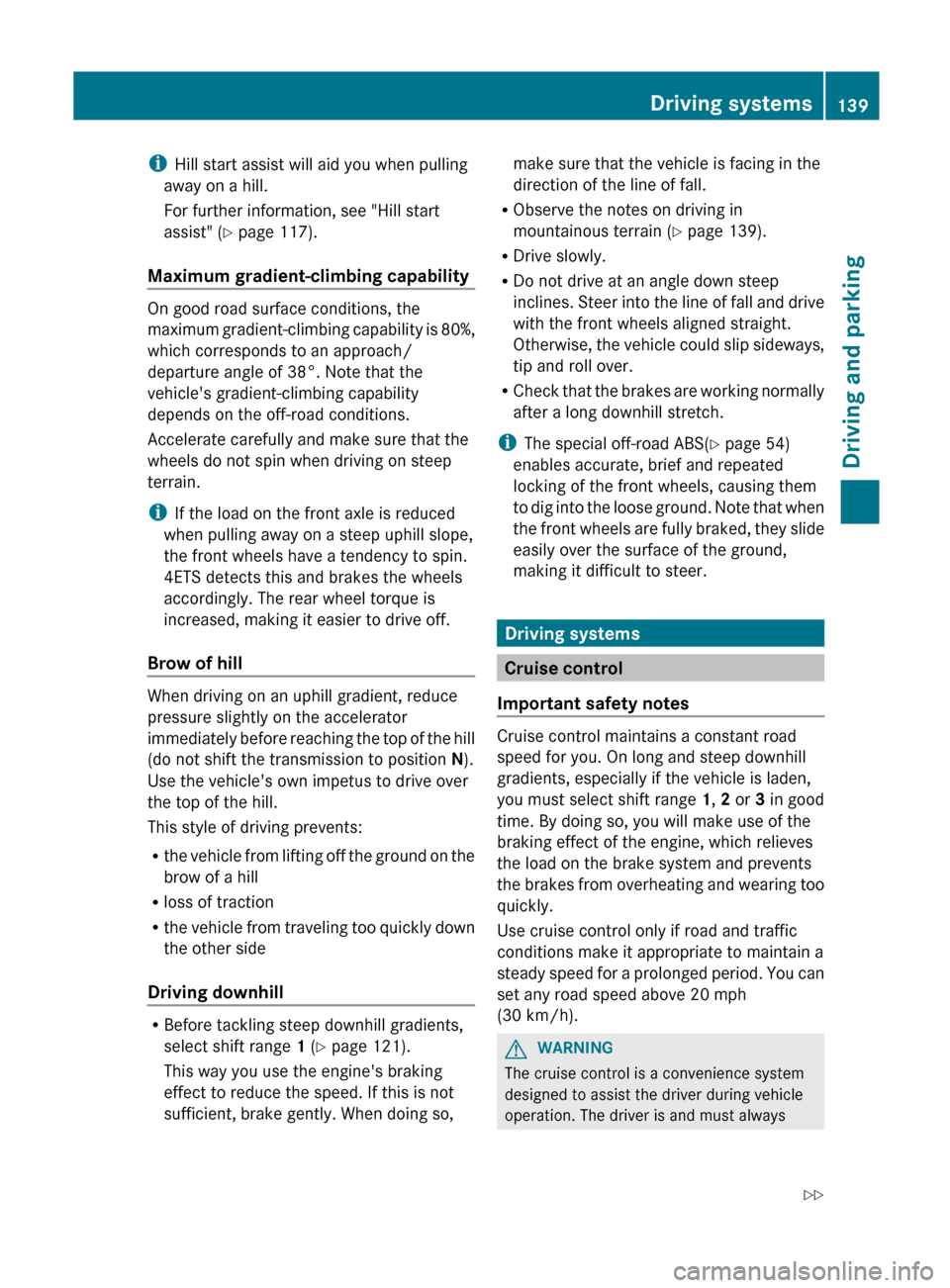
i
Hill start assist will aid you when pulling
away on a hill.
For further information, see "Hill start
assist" ( Y page 117).
Maximum gradient-climbing capability On good road surface conditions, the
maximum
gradient-climbing
capability is 80%,
which corresponds to an approach/
departure angle of 38°. Note that the
vehicle's gradient-climbing capability
depends on the off-road conditions.
Accelerate carefully and make sure that the
wheels do not spin when driving on steep
terrain.
i If the load on the front axle is reduced
when pulling away on a steep uphill slope,
the front wheels have a tendency to spin.
4ETS detects this and brakes the wheels
accordingly. The rear wheel torque is
increased, making it easier to drive off.
Brow of hill When driving on an uphill gradient, reduce
pressure slightly on the accelerator
immediately
before
reaching the top of the hill
(do not shift the transmission to position N).
Use the vehicle's own impetus to drive over
the top of the hill.
This style of driving prevents:
R the vehicle from lifting off the ground on the
brow of a hill
R loss of traction
R the vehicle from traveling too quickly down
the other side
Driving downhill R
Before tackling steep downhill gradients,
select shift range 1 (Y page 121).
This way you use the engine's braking
effect to reduce the speed. If this is not
sufficient, brake gently. When doing so, make sure that the vehicle is facing in the
direction of the line of fall.
R Observe the notes on driving in
mountainous terrain (Y page 139).
R Drive slowly.
R Do not drive at an angle down steep
inclines. Steer
into the line of fall and drive
with the front wheels aligned straight.
Otherwise, the vehicle could slip sideways,
tip and roll over.
R Check that the brakes are working normally
after a long downhill stretch.
i The special off-road ABS(Y page 54)
enables accurate, brief and repeated
locking of the front wheels, causing them
to dig into the loose ground. Note that when
the front wheels are fully braked, they slide
easily over the surface of the ground,
making it difficult to steer. Driving systems
Cruise control
Important safety notes Cruise control maintains a constant road
speed for you. On long and steep downhill
gradients, especially if the vehicle is laden,
you must select shift range 1, 2 or 3 in good
time. By doing so, you will make use of the
braking effect of the engine, which relieves
the load on the brake system and prevents
the
brakes
from overheating and wearing too
quickly.
Use cruise control only if road and traffic
conditions make it appropriate to maintain a
steady speed for a prolonged period. You can
set any road speed above 20 mph
(30 km/h). G
WARNING
The cruise control is a convenience system
designed to assist the driver during vehicle
operation. The driver is and must always Driving systems
139
Driving and parking
Z
Page 142 of 284
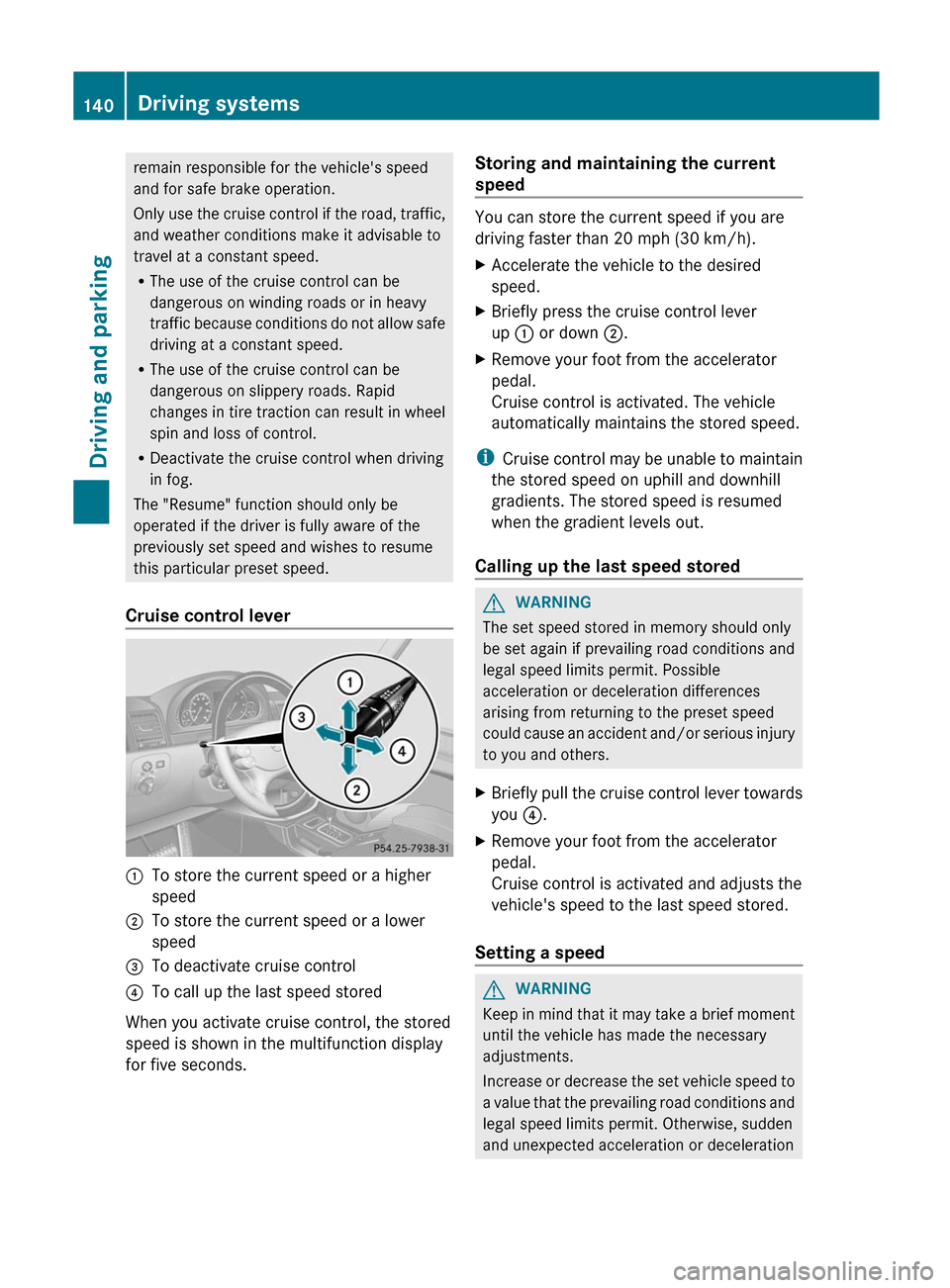
remain responsible for the vehicle's speed
and for safe brake operation.
Only
use
the cruise control if the road, traffic,
and weather conditions make it advisable to
travel at a constant speed.
R The use of the cruise control can be
dangerous on winding roads or in heavy
traffic because conditions do not allow safe
driving at a constant speed.
R The use of the cruise control can be
dangerous on slippery roads. Rapid
changes in tire traction can result in wheel
spin and loss of control.
R Deactivate the cruise control when driving
in fog.
The "Resume" function should only be
operated if the driver is fully aware of the
previously set speed and wishes to resume
this particular preset speed.
Cruise control lever :
To store the current speed or a higher
speed
; To store the current speed or a lower
speed
= To deactivate cruise control
? To call up the last speed stored
When you activate cruise control, the stored
speed is shown in the multifunction display
for five seconds. Storing and maintaining the current
speed You can store the current speed if you are
driving faster than 20 mph (30 km/h
).
X Accelerate the vehicle to the desired
speed.
X Briefly press the cruise control lever
up :
or down ;.
X Remove your foot from the accelerator
pedal.
Cruise control is activated. The vehicle
automatically maintains the stored speed.
i Cruise control
may be unable to maintain
the stored speed on uphill and downhill
gradients. The stored speed is resumed
when the gradient levels out.
Calling up the last speed stored G
WARNING
The set speed stored in memory should only
be set again if prevailing road conditions and
legal speed limits permit. Possible
acceleration or deceleration differences
arising from returning to the preset speed
could cause
an accident and/or serious injury
to you and others.
X Briefly pull the cruise control lever towards
you ?.
X Remove your foot from the accelerator
pedal.
Cruise control is activated and adjusts the
vehicle's speed to the last speed stored.
Setting a speed G
WARNING
Keep
in mind that it may take a brief moment
until the vehicle has made the necessary
adjustments.
Increase or
decrease the set vehicle speed to
a value that the prevailing road conditions and
legal speed limits permit. Otherwise, sudden
and unexpected acceleration or deceleration 140
Driving systems
Driving and parking
Page 143 of 284
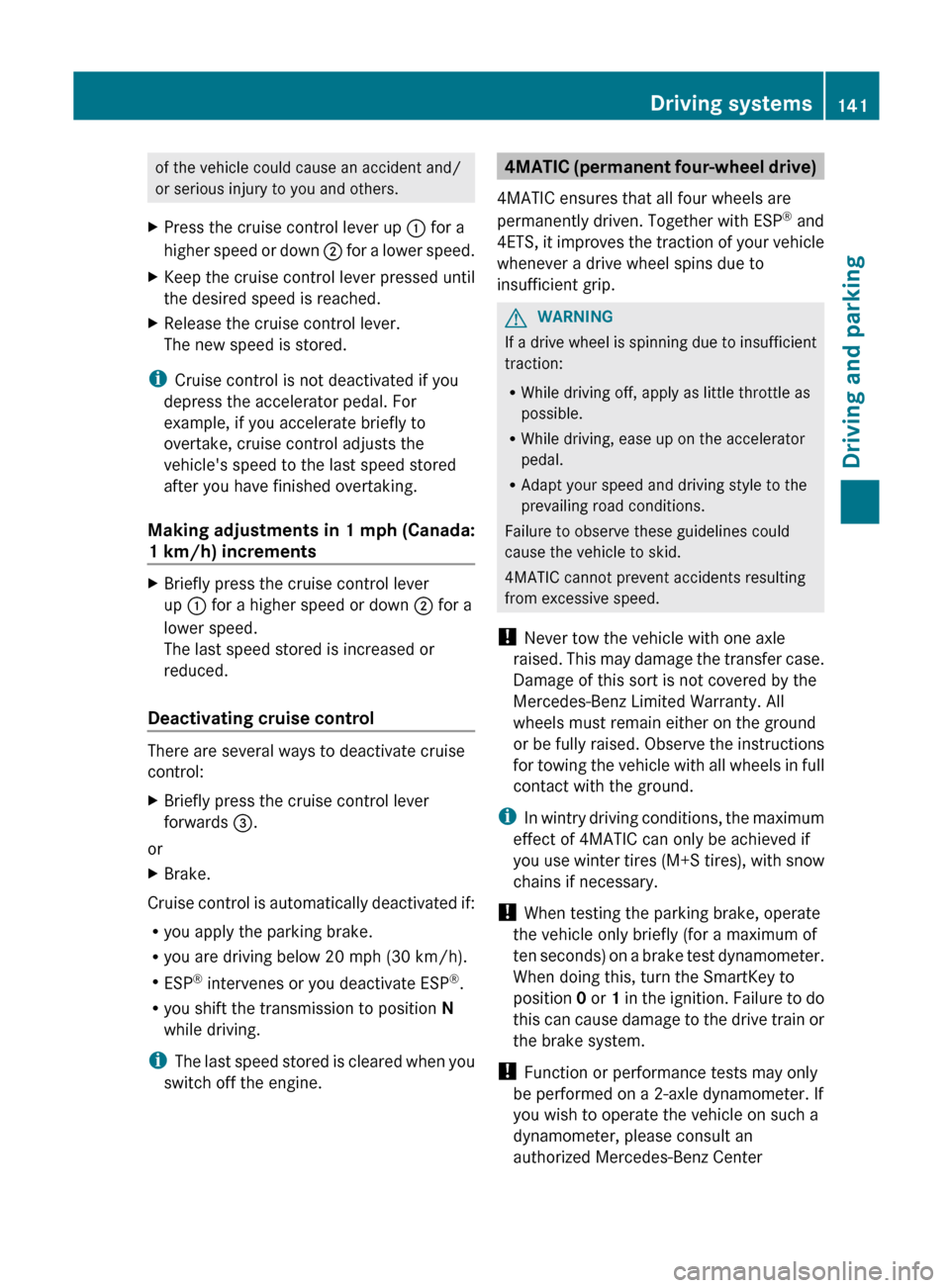
of the vehicle could cause an accident and/
or serious injury to you and others.
X Press the cruise control lever up : for a
higher speed
or down ; for a lower speed.
X Keep the cruise control lever pressed until
the desired speed is reached.
X Release the cruise control lever.
The new speed is stored.
i Cruise control is not deactivated if you
depress the accelerator pedal. For
example, if you accelerate briefly to
overtake, cruise control adjusts the
vehicle's speed to the last speed stored
after you have finished overtaking.
Making adjustments in 1 mph
(Canada:
1 km/h) increments X
Briefly press the cruise control lever
up :
for a higher speed or down
; for a
lower speed.
The last speed stored is increased or
reduced.
Deactivating cruise control There are several ways to deactivate cruise
control:
X
Briefly press the cruise control lever
forwards = .
or
X Brake.
Cruise control is automatically deactivated if:
R you apply the parking brake.
R you are driving below 20 mph (30 km/h
).
R ESP ®
intervenes or you deactivate ESP ®
.
R you shift the transmission to position N
while driving.
i The last speed stored is cleared when you
switch off the engine. 4MATIC
(permanent four-wheel drive)
4MATIC ensures that all four wheels are
permanently driven. Together with ESP ®
and
4ETS, it
improves the traction of your vehicle
whenever a drive wheel spins due to
insufficient grip. G
WARNING
If
a drive wheel is spinning due to insufficient
traction:
R While driving off, apply as little throttle as
possible.
R While driving, ease up on the accelerator
pedal.
R Adapt your speed and driving style to the
prevailing road conditions.
Failure to observe these guidelines could
cause the vehicle to skid.
4MATIC cannot prevent accidents resulting
from excessive speed.
! Never tow the vehicle with one axle
raised. This
may damage the transfer case.
Damage of this sort is not covered by the
Mercedes-Benz Limited Warranty. All
wheels must remain either on the ground
or be fully raised. Observe the instructions
for towing the vehicle with all wheels in full
contact with the ground.
i In wintry driving conditions, the maximum
effect of 4MATIC can only be achieved if
you use winter tires (M+S tires), with snow
chains if necessary.
! When testing the parking brake, operate
the vehicle only briefly (for a maximum of
ten seconds) on a brake test dynamometer.
When doing this, turn the SmartKey to
position 0 or 1 in the ignition. Failure to do
this can cause damage to the drive train or
the brake system.
! Function or performance tests may only
be performed on a 2-axle dynamometer. If
you wish to operate the vehicle on such a
dynamometer, please consult an
authorized Mercedes-Benz Center Driving systems
141
Driving and parking Z
Page 144 of 284
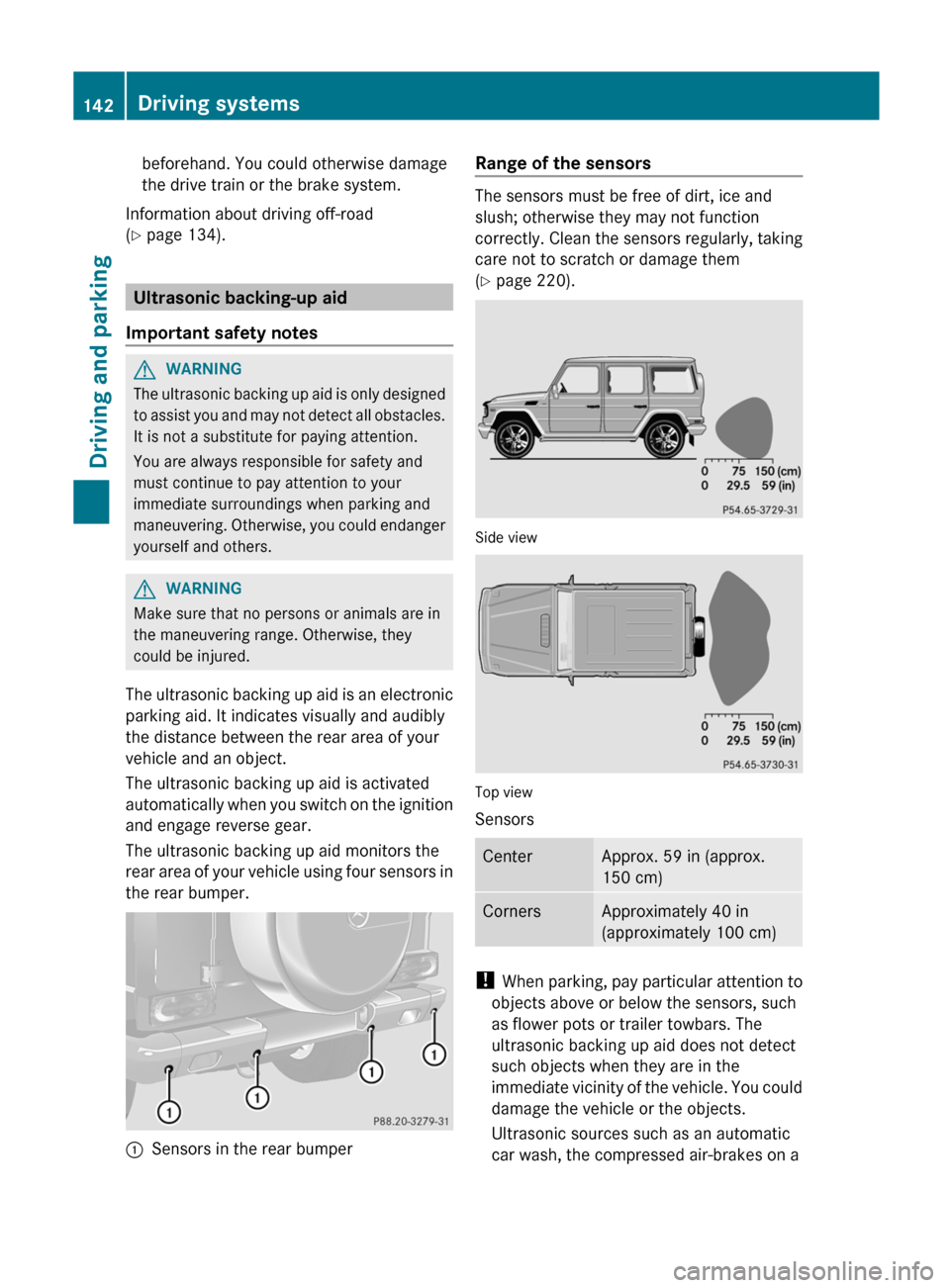
beforehand. You could otherwise damage
the drive train or the brake system.
Information about driving off-road
(Y page 134). Ultrasonic backing-up aid
Important safety notes G
WARNING
The ultrasonic backing up aid is only designed
to assist
you and may not detect all obstacles.
It is not a substitute for paying attention.
You are always responsible for safety and
must continue to pay attention to your
immediate surroundings when parking and
maneuvering. Otherwise, you could endanger
yourself and others. G
WARNING
Make sure that no persons or animals are in
the maneuvering range. Otherwise, they
could be injured.
The ultrasonic
backing up aid is an electronic
parking aid. It indicates visually and audibly
the distance between the rear area of your
vehicle and an object.
The ultrasonic backing up aid is activated
automatically when you switch on the ignition
and engage reverse gear.
The ultrasonic backing up aid monitors the
rear area of your vehicle using four sensors in
the rear bumper. :
Sensors in the rear bumper Range of the sensors The sensors must be free of dirt, ice and
slush; otherwise they may not function
correctly.
Clean
the sensors regularly, taking
care not to scratch or damage them
(Y page 220). Side view
Top view
Sensors
Center Approx. 59 in (approx.
150 cm)
Corners Approximately 40 in
(approximately 100 cm)
!
When parking,
pay particular attention to
objects above or below the sensors, such
as flower pots or trailer towbars. The
ultrasonic backing up aid does not detect
such objects when they are in the
immediate vicinity of the vehicle. You could
damage the vehicle or the objects.
Ultrasonic sources such as an automatic
car wash, the compressed air-brakes on a 142
Driving systems
Driving and parking
Page 145 of 284
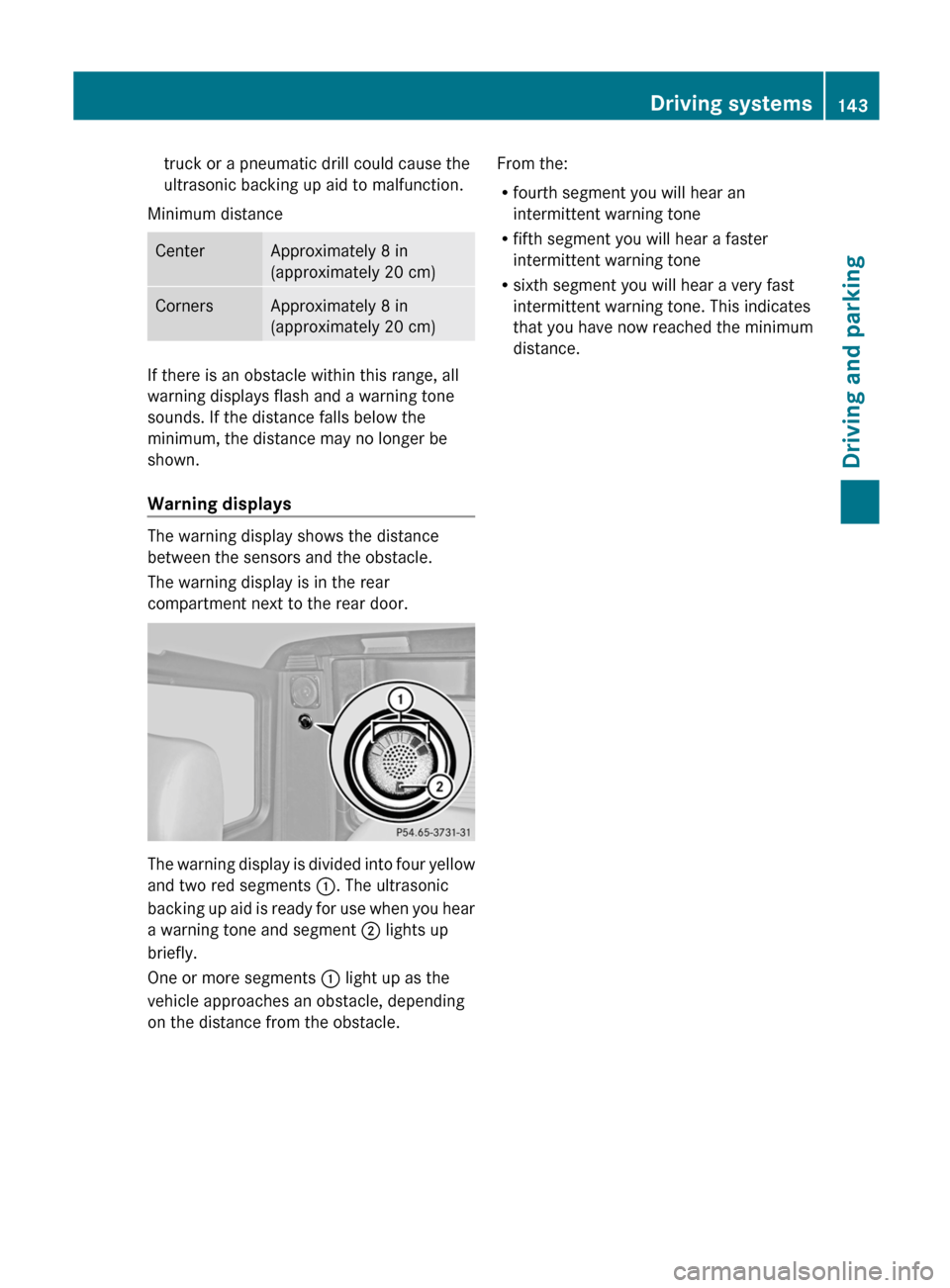
truck or a pneumatic drill could cause the
ultrasonic backing up aid to malfunction.
Minimum distance Center Approximately 8 in
(approximately 20 cm)
Corners Approximately 8 in
(approximately 20 cm)
If there is an obstacle within this range, all
warning displays flash and a warning tone
sounds. If the distance falls below the
minimum, the distance may no longer be
shown.
Warning displays
The warning display shows the distance
between the sensors and the obstacle.
The warning display is in the rear
compartment next to the rear door.
The warning display is divided into four yellow
and two red segments :. The ultrasonic
backing
up
aid is ready for use when you hear
a warning tone and segment ; lights up
briefly.
One or more segments : light up as the
vehicle approaches an obstacle, depending
on the distance from the obstacle. From the:
R
fourth segment you will hear an
intermittent warning tone
R fifth segment you will hear a faster
intermittent warning tone
R sixth segment you will hear a very fast
intermittent warning tone. This indicates
that you have now reached the minimum
distance. Driving systems
143
Driving and parking Z
Page 146 of 284
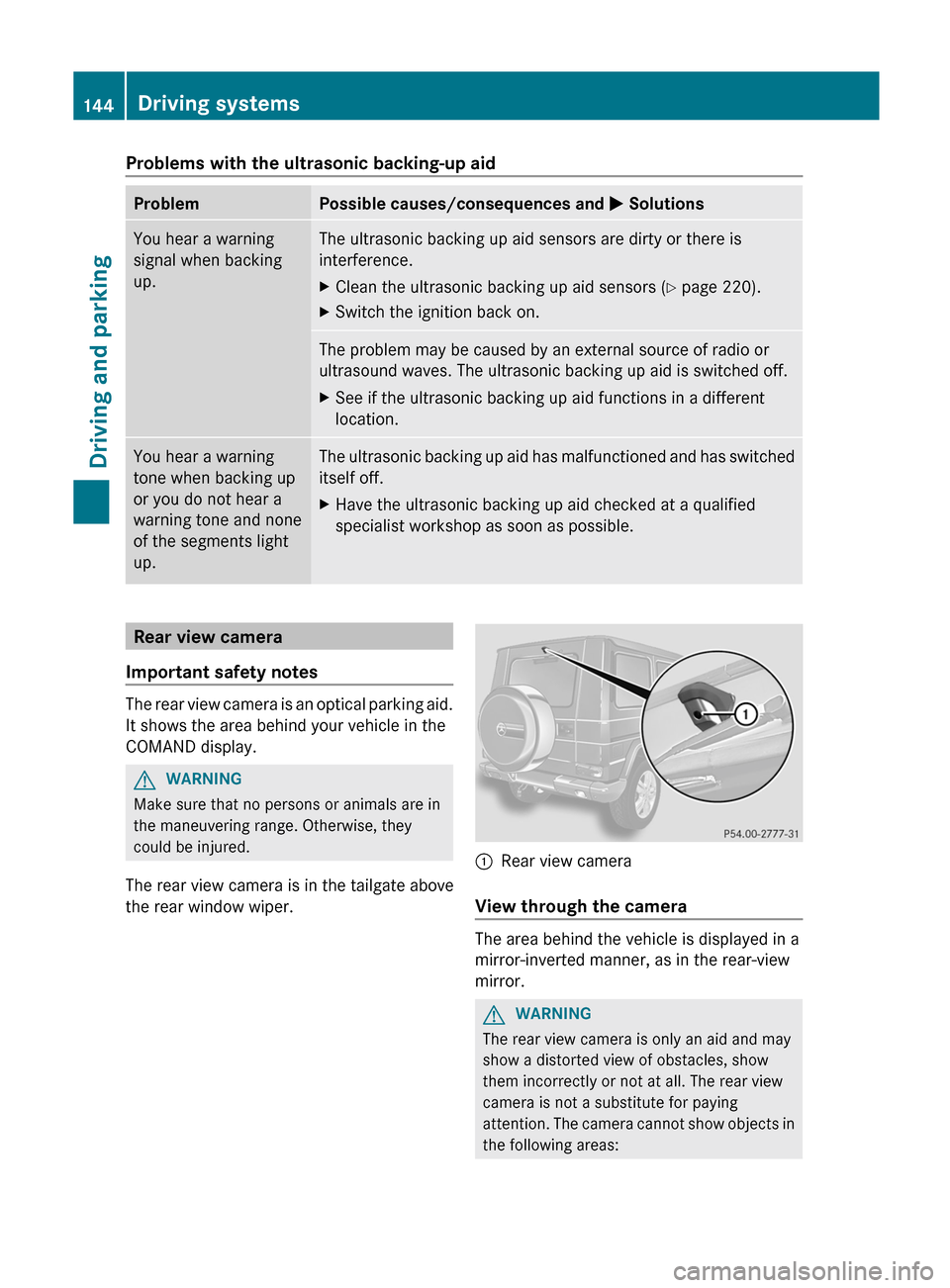
Problems with the ultrasonic backing-up aid
Problem Possible causes/consequences and
M SolutionsYou hear a warning
signal when backing
up. The ultrasonic backing up aid sensors are dirty or there is
interference.
X
Clean the ultrasonic backing up aid sensors ( Y page 220).
X Switch the ignition back on. The problem may be caused by an external source of radio or
ultrasound waves. The ultrasonic backing up aid is switched off.
X
See if the ultrasonic backing up aid functions in a different
location. You hear a warning
tone when backing up
or you do not hear a
warning tone and none
of the segments light
up. The ultrasonic backing up aid has malfunctioned and has switched
itself off.
X
Have the ultrasonic backing up aid checked at a qualified
specialist workshop as soon as possible. Rear view camera
Important safety notes The rear view camera is an optical parking aid.
It shows the area behind your vehicle in the
COMAND display.
G
WARNING
Make sure that no persons or animals are in
the maneuvering range. Otherwise, they
could be injured.
The rear view camera is in the tailgate above
the rear window wiper. :
Rear view camera
View through the camera The area behind the vehicle is displayed in a
mirror-inverted manner, as in the rear-view
mirror.
G
WARNING
The rear view camera is only an aid and may
show a distorted view of obstacles, show
them incorrectly or not at all. The rear view
camera is not a substitute for paying
attention. The
camera cannot show objects in
the following areas: 144
Driving systems
Driving and parking
Page 147 of 284
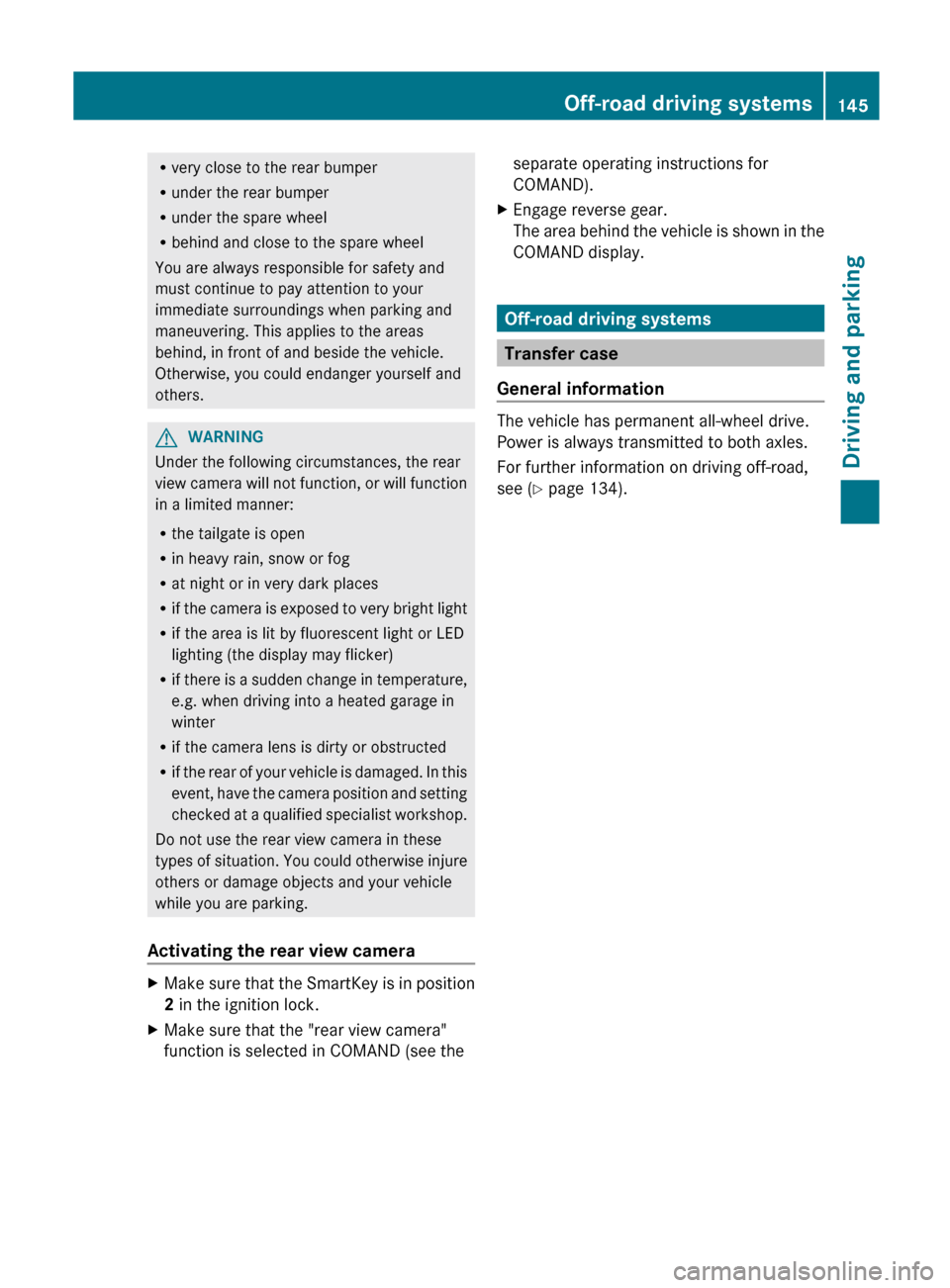
R
very close to the rear bumper
R under the rear bumper
R under the spare wheel
R behind and close to the spare wheel
You are always responsible for safety and
must continue to pay attention to your
immediate surroundings when parking and
maneuvering. This applies to the areas
behind, in front of and beside the vehicle.
Otherwise, you could endanger yourself and
others. G
WARNING
Under the following circumstances, the rear
view camera
will not function, or will function
in a limited manner:
R the tailgate is open
R in heavy rain, snow or fog
R at night or in very dark places
R if the camera is exposed to very bright light
R if the area is lit by fluorescent light or LED
lighting (the display may flicker)
R if there is a sudden change in temperature,
e.g. when driving into a heated garage in
winter
R if the camera lens is dirty or obstructed
R if the rear of your vehicle is damaged. In this
event, have the camera position and setting
checked at a qualified specialist workshop.
Do not use the rear view camera in these
types of situation. You could otherwise injure
others or damage objects and your vehicle
while you are parking.
Activating the rear view camera X
Make
sure that the SmartKey is in position
2 in the ignition lock.
X Make sure that the "rear view camera"
function is selected in COMAND (see the separate operating instructions for
COMAND).
X Engage reverse gear.
The area
behind the vehicle is shown in the
COMAND display. Off-road driving systems
Transfer case
General information The vehicle has permanent all-wheel drive.
Power is always transmitted to both axles.
For further information on driving off-road,
see (
Y
page 134). Off-road driving systems
145
Driving and parking Z
Page 148 of 284
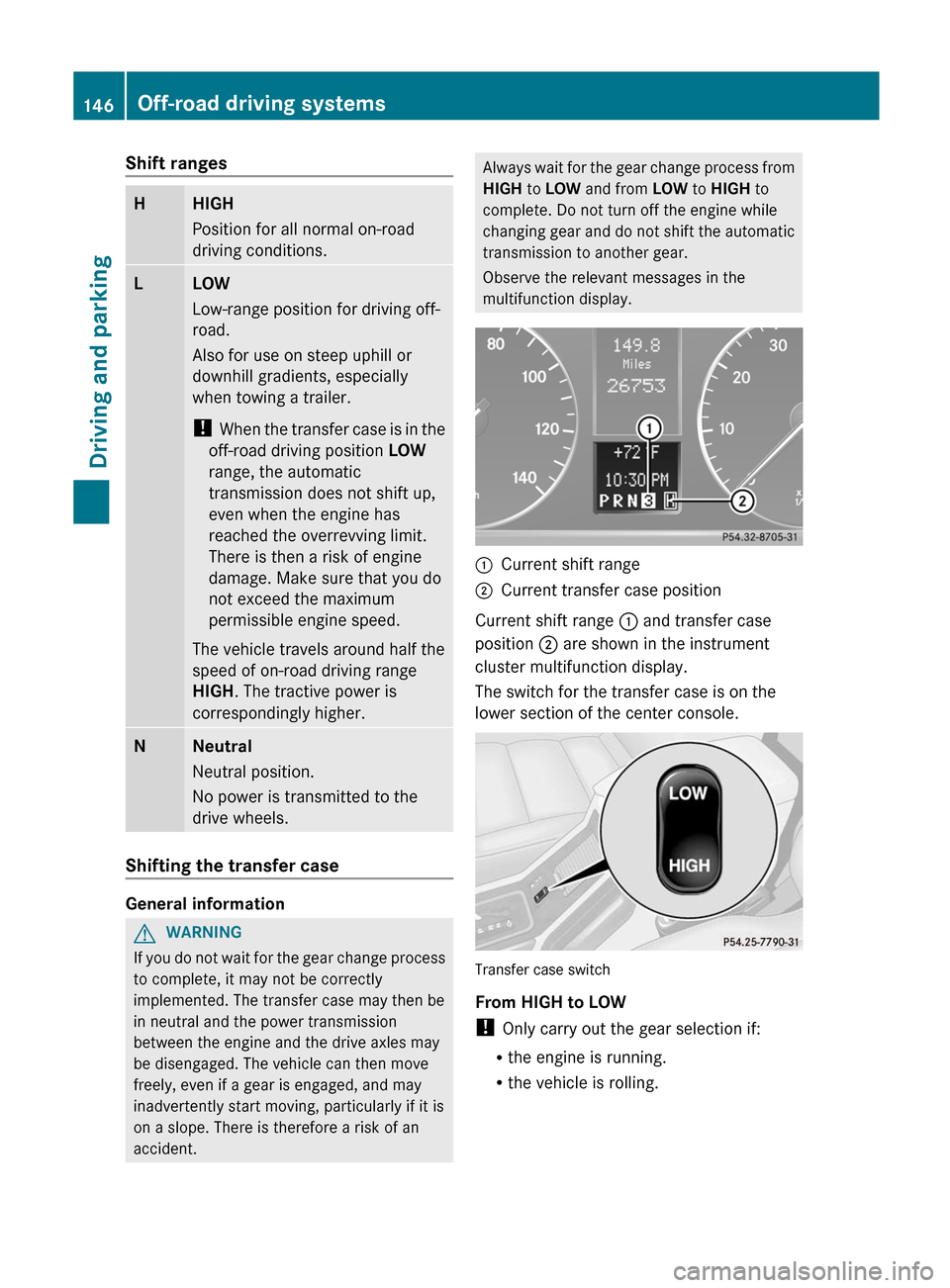
Shift ranges
H HIGH
Position for all normal on-road
driving conditions.
L LOW
Low-range position for driving off-
road.
Also for use on steep uphill or
downhill gradients, especially
when towing a trailer.
!
When the
transfer case is in the
off-road driving position LOW
range, the automatic
transmission does not shift up,
even when the engine has
reached the overrevving limit.
There is then a risk of engine
damage. Make sure that you do
not exceed the maximum
permissible engine speed.
The vehicle travels around half the
speed of on-road driving range
HIGH. The tractive power is
correspondingly higher. N Neutral
Neutral position.
No power is transmitted to the
drive wheels.
Shifting the transfer case
General information
G
WARNING
If you do not wait for the gear change process
to complete, it may not be correctly
implemented. The transfer case may then be
in neutral and the power transmission
between the engine and the drive axles may
be disengaged. The vehicle can then move
freely, even if a gear is engaged, and may
inadvertently start moving, particularly if it is
on a slope. There is therefore a risk of an
accident. Always wait for the gear change process from
HIGH to LOW and from LOW to HIGH to
complete. Do not turn off the engine while
changing
gear
and do not shift the automatic
transmission to another gear.
Observe the relevant messages in the
multifunction display. :
Current shift range
; Current transfer case position
Current shift range : and transfer case
position ; are shown in the instrument
cluster multifunction display.
The switch for the transfer case is on the
lower section of the center console. Transfer case switch
From HIGH to LOW
!
Only carry out the gear selection if:
R the engine is running.
R the vehicle is rolling.146
Off-road driving systems
Driving and parking
Page 149 of 284
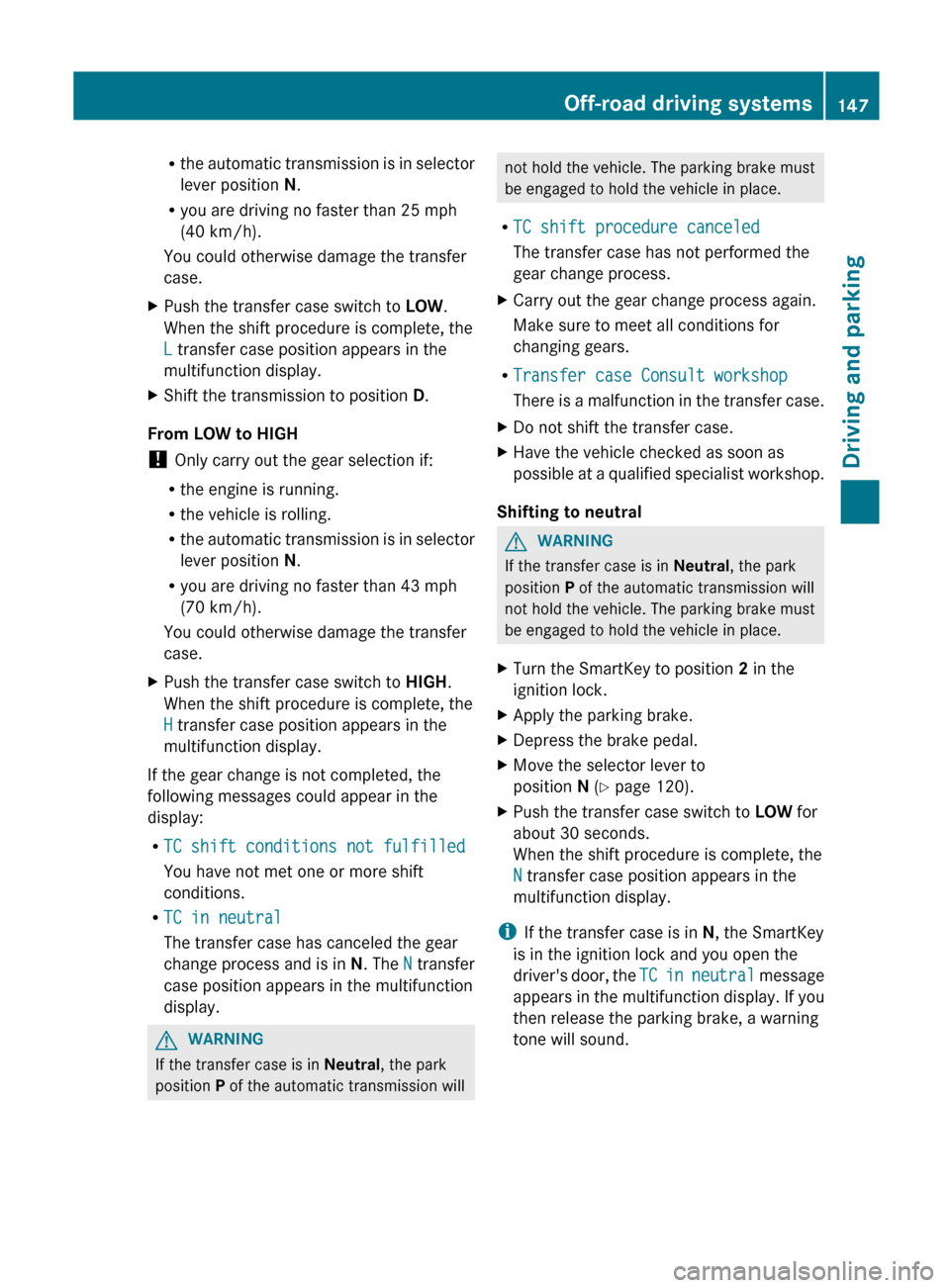
R
the automatic transmission is in selector
lever position N.
R you are driving no faster than 25 mph
(40 km/h).
You could otherwise damage the transfer
case.
X Push the transfer case switch to LOW.
When the shift procedure is complete, the
L transfer case position appears in the
multifunction display.
X Shift the transmission to position D.
From LOW to HIGH
! Only carry out the gear selection if:
R the engine is running.
R the vehicle is rolling.
R the automatic
transmission is in selector
lever position N.
R you are driving no faster than 43 mph
(70 km/h).
You could otherwise damage the transfer
case.
X Push the transfer case switch to HIGH.
When the shift procedure is complete, the
H transfer case position appears in the
multifunction display.
If the gear change is not completed, the
following messages could appear in the
display:
R TC shift conditions not fulfilled
You have not met one or more shift
conditions.
R TC in neutral
The transfer case has canceled the gear
change process and is in N. The N transfer
case position appears in the multifunction
display. G
WARNING
If the transfer case is in Neutral, the park
position P of the automatic transmission will not hold the vehicle. The parking brake must
be engaged to hold the vehicle in place.
R TC shift procedure canceled
The transfer case has not performed the
gear change process.
X Carry out the gear change process again.
Make sure to meet all conditions for
changing gears.
R Transfer case Consult workshop
There is
a malfunction in the transfer case.
X Do not shift the transfer case.
X Have the vehicle checked as soon as
possible at
a qualified specialist workshop.
Shifting to neutral G
WARNING
If the transfer case is in Neutral, the park
position P of the automatic transmission will
not hold the vehicle. The parking brake must
be engaged to hold the vehicle in place.
X Turn the SmartKey to position 2 in the
ignition lock.
X Apply the parking brake.
X Depress the brake pedal.
X Move the selector lever to
position N (Y page 120).
X Push the transfer case switch to LOW for
about 30 seconds.
When the shift procedure is complete, the
N transfer case position appears in the
multifunction display.
i If the transfer case is in N, the SmartKey
is in the ignition lock and you open the
driver's door,
the TC in neutral message
appears in the multifunction display. If you
then release the parking brake, a warning
tone will sound. Off-road driving systems
147
Driving and parking Z
Page 150 of 284
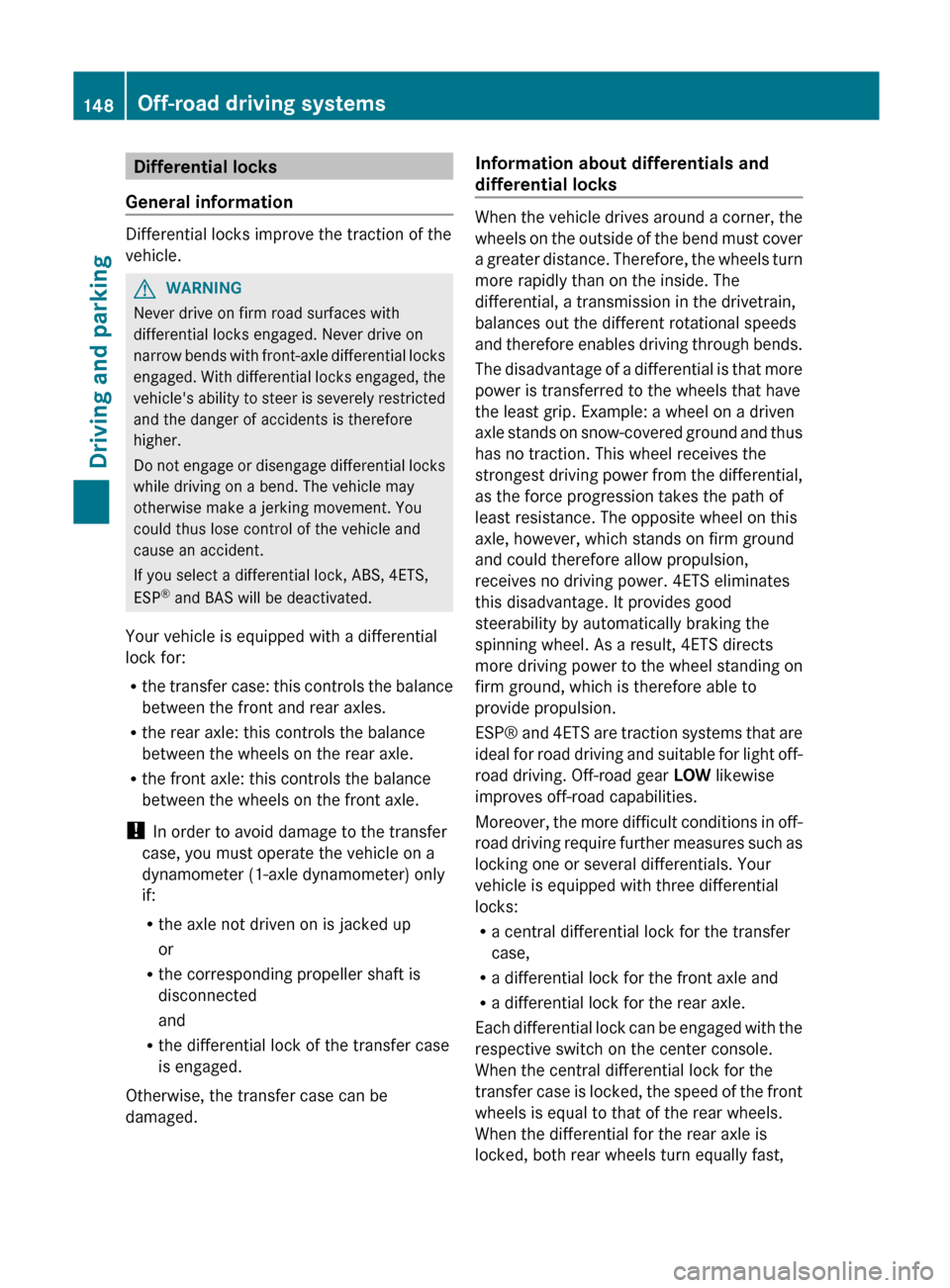
Differential locks
General information Differential locks improve the traction of the
vehicle.
G
WARNING
Never drive on firm road surfaces with
differential locks engaged. Never drive on
narrow bends
with front-axle differential locks
engaged. With differential locks engaged, the
vehicle's ability to steer is severely restricted
and the danger of accidents is therefore
higher.
Do not engage or disengage differential locks
while driving on a bend. The vehicle may
otherwise make a jerking movement. You
could thus lose control of the vehicle and
cause an accident.
If you select a differential lock, ABS, 4ETS,
ESP ®
and BAS will be deactivated.
Your vehicle is equipped with a differential
lock for:
R the transfer case: this controls the balance
between the front and rear axles.
R the rear axle: this controls the balance
between the wheels on the rear axle.
R the front axle: this controls the balance
between the wheels on the front axle.
! In order to avoid damage to the transfer
case, you must operate the vehicle on a
dynamometer (1-axle dynamometer) only
if:
R the axle not driven on is jacked up
or
R the corresponding propeller shaft is
disconnected
and
R the differential lock of the transfer case
is engaged.
Otherwise, the transfer case can be
damaged. Information about differentials and
differential locks When
the vehicle drives around a corner, the
wheels on
the outside of the bend must cover
a greater distance. Therefore, the wheels turn
more rapidly than on the inside. The
differential, a transmission in the drivetrain,
balances out the different rotational speeds
and therefore enables driving through bends.
The disadvantage of a differential is that more
power is transferred to the wheels that have
the least grip. Example: a wheel on a driven
axle stands on snow-covered ground and thus
has no traction. This wheel receives the
strongest driving power from the differential,
as the force progression takes the path of
least resistance. The opposite wheel on this
axle, however, which stands on firm ground
and could therefore allow propulsion,
receives no driving power. 4ETS eliminates
this disadvantage. It provides good
steerability by automatically braking the
spinning wheel. As a result, 4ETS directs
more driving power to the wheel standing on
firm ground, which is therefore able to
provide propulsion.
ESP® and 4ETS are traction systems that are
ideal for road driving and suitable for light off-
road driving. Off-road gear LOW likewise
improves off-road capabilities.
Moreover, the more difficult conditions in off-
road driving require further measures such as
locking one or several differentials. Your
vehicle is equipped with three differential
locks:
R a central differential lock for the transfer
case,
R a differential lock for the front axle and
R a differential lock for the rear axle.
Each differential lock can be engaged with the
respective switch on the center console.
When the central differential lock for the
transfer case is locked, the speed of the front
wheels is equal to that of the rear wheels.
When the differential for the rear axle is
locked, both rear wheels turn equally fast, 148
Off-road driving systems
Driving and parking